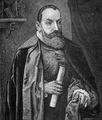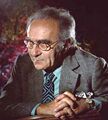Template:Selected anniversaries/August 22: Difference between revisions
Jump to navigation
Jump to search
No edit summary |
No edit summary |
||
| Line 2: | Line 2: | ||
||1572: Rudolph Goclenius the Younger born ... physician and professor of physics, medicine and mathematics at the Philipps University of Marburg. He was the oldest son of Rudolph Goclenius, who was also professor of rhetoric, logic and ethics at Marburg. As a physician he worked on cures against the plague. He became famous for his miraculous cure with the "weapon salve" or Powder of Sympathy. Based on the hermetic concepts of Paracelsus he published 1608 the proposition of a "magnetic" cure to heal wounds: the application of the salve on the weapon should heal the wounds afflicted by the weapon. This concept was brought to England by the alchemist Robert Fludd. A famous proponent was Sir Kenelm Digby. Synchronising the effects of the powder (which apparently caused a noticeable effect on the patient when applied) was actually suggested in the leaflet Curious Enquiries in 1687 as a means of solving the longitude problem. Pic. | ||1572: Rudolph Goclenius the Younger born ... physician and professor of physics, medicine and mathematics at the Philipps University of Marburg. He was the oldest son of Rudolph Goclenius, who was also professor of rhetoric, logic and ethics at Marburg. As a physician he worked on cures against the plague. He became famous for his miraculous cure with the "weapon salve" or Powder of Sympathy. Based on the hermetic concepts of Paracelsus he published 1608 the proposition of a "magnetic" cure to heal wounds: the application of the salve on the weapon should heal the wounds afflicted by the weapon. This concept was brought to England by the alchemist Robert Fludd. A famous proponent was Sir Kenelm Digby. Synchronising the effects of the powder (which apparently caused a noticeable effect on the patient when applied) was actually suggested in the leaflet Curious Enquiries in 1687 as a means of solving the longitude problem. Pic. | ||
File:Denis Papin.jpg|link=Denis Papin (nonfiction)|1647: Physicist, mathematician, and inventor [[Denis Papin (nonfiction)|Denis Papin]] born. | File:Denis Papin.jpg|link=Denis Papin (nonfiction)|1647: Physicist, mathematician, and inventor [[Denis Papin (nonfiction)|Denis Papin]] born. Papin will invent the steam digester, the forerunner of the pressure cooker and the steam engine. | ||
||1664: Maria Cunitz dies ... astronomer, and one of the most notable female astronomers of the modern era. She authored a book ''Urania propitia'', in which she provided new tables, new ephemera, and a more elegant solution to Kepler's problem. Pic. | ||1664: Maria Cunitz dies ... astronomer, and one of the most notable female astronomers of the modern era. She authored a book ''Urania propitia'', in which she provided new tables, new ephemera, and a more elegant solution to Kepler's problem. Pic. | ||
Revision as of 11:51, 22 August 2020
1647: Physicist, mathematician, and inventor Denis Papin born. Papin will invent the steam digester, the forerunner of the pressure cooker and the steam engine.
1854: Poet Jan Kochanowski dies. He established poetic patterns which would become integral to the Polish literary language.
1920: Science fiction writer and screenwriter Ray Bradbury born. The New York Times will call Bradbury "the writer most responsible for bringing modern science fiction into the literary mainstream".
1943: Signed first edition of Janet Beta at ENIAC traded for freshly minted 1943 Eleanor Roosevelt dime.
1974: Mathematician, historian of science, theatre author, poet, and inventor Jacob Bronowski dies.




